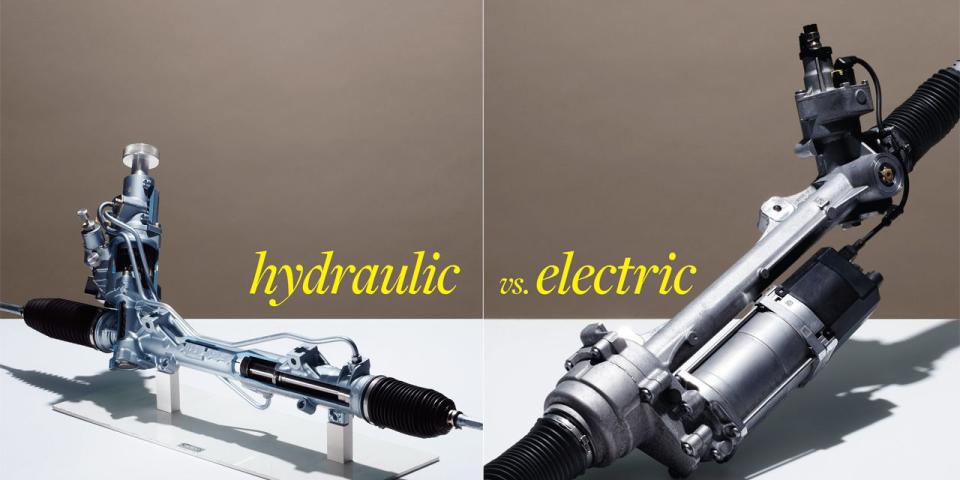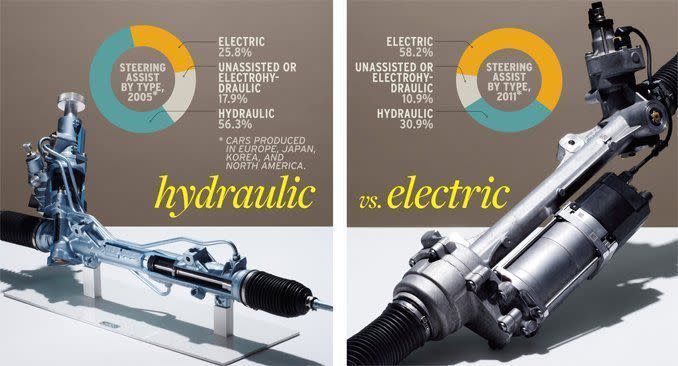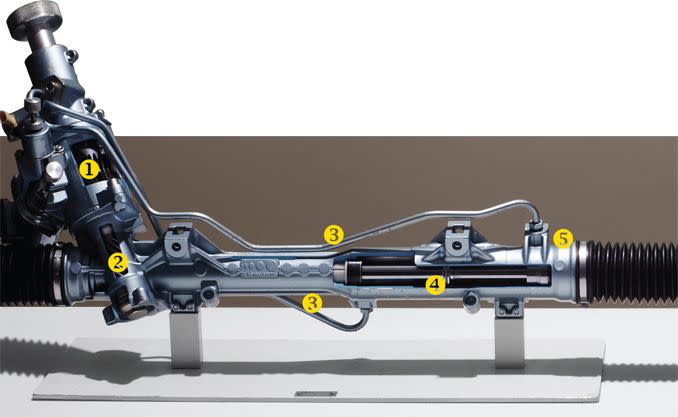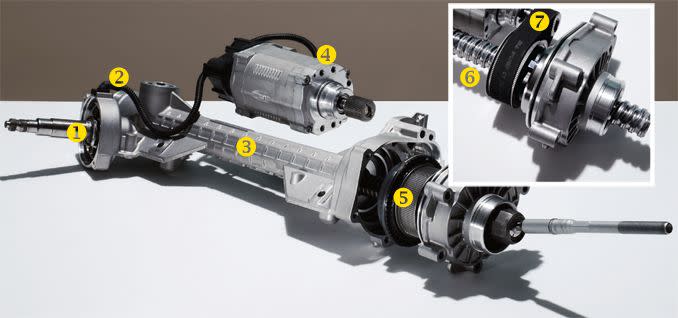Are We Losing Touch? A Comprehensive Comparison Test of Electric and Hydraulic Steering Assist

Technology is a fickle friend, nudging us forward with one hand while charging exorbitant tolls with the other. Modern engines that impress us with power and efficiency are being decoupled from the manual transmissions that help them sing. Stout body structures guard us from peril in a crash but are so heavy and hard to see out of that we’re more liable to bump into hazards easily avoided by truly wieldy cars. Electronic stability and traction aids are wonderful except when there’s no way to disable them.
Electrically assisted power steering (EPS) is the latest technological cross we bear. Replacing hydraulic assist with a computer-controlled electric motor seemed like a reasonable idea when it first surfaced. Someday every car control will be by-wire; today’s EPS looks like a step in that direction. But in the past decade of driving EPS-equipped cars, we’ve found them lacking in feel, poorly tuned, and sometimes simply weird in comparison with the hydraulic-assist setups that have benefited from more than half a century of development.
This matters because steering is the driver’s main line of communication with the car; distortion in the guidance channel makes every other perception more difficult to comprehend.
Hydraulic Power Steering
The steering gear's internal cavity is divided into two chambers by a sealed piston attached to the rack. Applying pressurized hydraulic fluid to one side of the piston while allowing fluid to return from the other side to a reservoir provides steering assistance. A valve attached to the pinion shaft controls the hydraulic-fluid flow.

Hydraulic Pressure/Return Lines

Rack Housing
Electric Power Steering
To provide steering assistance, an electric motor mounted to the side of the rack housing drives a ball-screw mechanism via a toothed rubber belt. The screw engages a spiral cut in the outside of the steering rack. A torque sensor attached to the pinion shaft signals a control computer when to provide assistance.

Electric Motor

Drive Belt
Makers are moving aggressively to EPS because eliminating an engine-driven hydraulic pump increases gas mileage by about 1 mpg. Before hydraulic power steering (HPS) goes the way of the buggy whip, though, we wanted to understand the differences so we concocted this test. BMW conveniently offers both types of assist on 5-series models equipped with four-wheel drive. (HPS survives here because the slightly bulkier EPS unit fits in only the four-cylinder model.) A $61,125 BMW 528i xDrive served as our EPS lab rat while its 535i xDrive ($69,695) sibling stood up for HPS. Beyond the type of steering assistance, the notable differences are six cylinders in the 535i xDrive versus four in the 528i xDrive, 143 pounds more weight on the more expensive BMW’s front axle, and 19-inch 40-series tires (535i) versus 18-inch 45-series rubber on the 528i. The basic run-flat, all-season tire design and 245-mm section width are common to both.
We divided our test into two segments-a hands-on, purely subjective driving evaluation, followed by instrumented proving-grounds tests. For the first phase, a steering committee of 11 editors with many decades of combined experience drove the BMWs-without knowing what type of steering assist was at work-over our favorite southeast Michigan test loop: 13.8 miles of whoops and hollows, sweeping lefts, and decreasing-radius rights; essentially our own North American Nordschleife. Each driver completed one 10-item ballot per car. Then the two BMWs were handed over to colleagues at Cayman Dynamics, where engineers fit an array of sensors and recorded for analysis the results of various steering-response tests.
Several of our findings were predictable; some surprised us. The first discovery was that neither BMW excels in steering feel and feedback, an observation consistent with the mediocre reviews we’ve given every 5-series, including the M5, since the sixth-generation design arrived three years ago.
After griping about EPS for years, the shocking revelation is that C/D’s editorial staff preferred BMW’s electric system over its hydraulic assistance. Total votes in seven out of ten rating categories favored EPS by two to eight points each. Hydraulic shined in only the three Feedback categories where it won the on-center comparison by four points and tied with EPS in our middle-of-maneuver and at-cornering-extremes performance ratings.


Click to Download Complete Performance Data and Specs

('You Might Also Like',)

 Yahoo Autos
Yahoo Autos 



